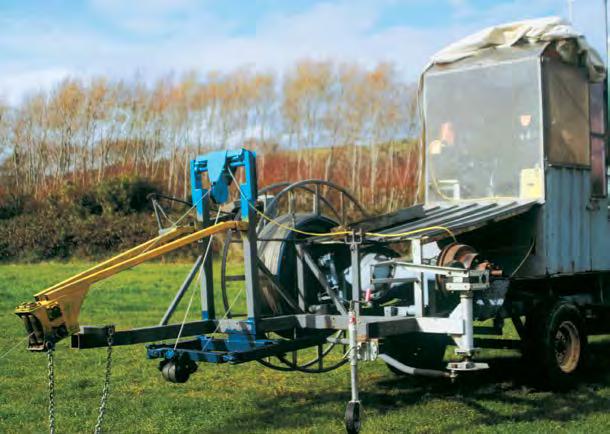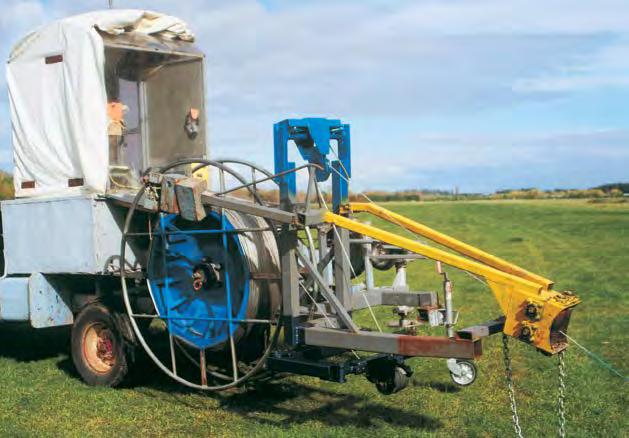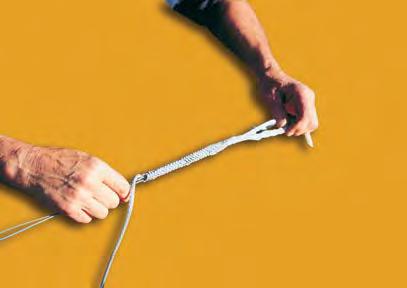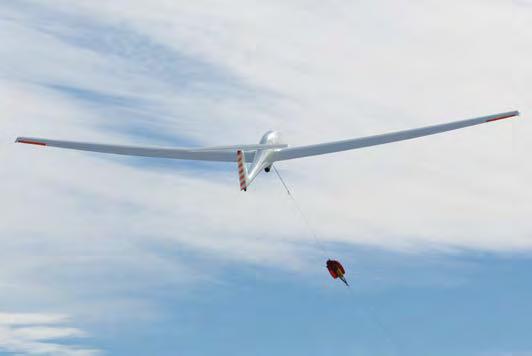
8 minute read
Towing Gliding Wairarapa’s Adventures
from SoaringNZ Issue 10
by mccawmedia
GLIDING WAIRARAPA’S ADVENTURES WITH DYNEEMA / DYNEX 75 / SPECTRA

Advertisement
by Jim Bidenell
During 1999, Gliding Wairarapa became interested in replacing the single strand 3.2 mm high tensile steel wire that had been in use on the winches since flying operations began in 1989. The wire was dangerous and at times a break under tension would drive loops many inches into the ground. I often worried what it could do to a human body.
Wire was also conductive and would sometimes come in contact with the farm’s electric fence system with shocking results for the club members retrieving the winch line. On one occasion a pilot during a launch drifted off course and carried the wire over adjacent 11,000 volt lines. The winch driver at the time coolly summed up the situation and ‘flew’ the parachute and winch wire safely back over the power lines without causing any damage. A strike from a charged cloud was also a possibility because at times a launch above 3000 ft would occur and even a small cumulonimbus cloud can pack a wallop.
Enquiries led the club to a Kevlar based product called Dyneema and we purchased a one kilometre length 5 mm in diameter. Its breaking strain is about two tonnes and its weight is one tenth that of steel wire of an equal breaking strain.
This one km length was added to the wire on the winch. The club pilots were amazed at the way the glider climbed away during the launch. This was largely due to the much lighter weight of the Kevlar cable. With wire we must have been adding an extra 200 kg of weight to the aircraft when we were already filling the cockpits with two bulky pilots. There was also a large reduction of noise in the aircraft due to the fact that the Dyneema blocked all the vibrations that had previously travelled along the wire from the winch.
We did experience many over-speed launches and a number of slow ones. Also the odd pilot would hang in there with the nose above the horizon verging on a stall. Why we did not have a spin off a launch I will never know.
About a year later the club purchased another kilometre of Dyneema, 6 mm diameter this time. The extra bulk filled the drum and at times a loop would form after a launch which tended to add to the winch driver’s woes. The original drum was built for wire and was only five inches wide, so thoughts turned to designing a new drum.
A rear wheel rim from a Ford tractor was selected. The dimensions were 12 inches wide and 36 inches in diameter. Observation of the Dyneema when it was being recovered after a launch showed that the braid became semi rigid and that loops would rise about 250 mm off the drum, so it was reasoned that the drum would need rims about a foot high to stop the loops from escaping and breaking the cord.
At this stage two agriculture wheels from a defunct silage wagon were used to lift the winch another 18 inches to accommodate the five foot diameter drum. A larger parachute was added to increase the recovery load on the cord.
A cable pay-on system has also been installed on the winch. It consists of an oscillating arm that moves the cable across the width of the drum. This has solved the cable stacking problem that had generated loops and tangles in the past. Evenly laid and tightly packed cable makes a 50 kph return to the glider launch end possible but a 100 kg weak link must be placed between the car and the winch line and the winch automatic transmission must be disengaged for speeds over 20 kph.
Kevlar, unless it is protected from UV radiation, will eventually fail. During 2007 the Club started to experience a number of cable breaks so we purchased a 200 metre length of 4mm Dynex
75 for evaluation. The Club has recently obtained three kilometres of 5mm Dynex 75. This cable has a UV protective coating but unlike the Dyneema is stretchable and it crushed the winch drum quite spectacularly when first used. Fifty per cent of the original drum was salvageable and after some intense effort in a local engineering shop an improved model is now in service.
A weak link has always been placed in the winch line near the parachute. (The breaking strain is recommended by the glider manufacturer and is also determined by the weight of the glider that is being launched.) It would appear that the weight of the launch cable was added to the weight of the glider in calculating the strength of the weak link. 5000 feet of cable or wire can weigh about 200 kg, whereas 5000 feet of Dyneema or Dynex 75 will only weigh about 25 kg. So it is possible to reduce the weak link load factor and improve the glider’s overload protection.
Until recently it has not been possible to measure the winch line loads during a launch unless a known weak link had failed. Some months ago a Gallagher livestock weighing unit was installed on the winch and a continuous readout is now available during a launch. Further improvements to this system are underway and in the near future it will be possible to graph the launch data and compare pilot and glider performance. Joining lengths of Dyneema is best accomplished with a splice. A fisherman’s knot will weaken the line strength by about 50%. To produce a splice overlap the ends of the braid by about 400 mm. Use a ball point pen or a Phillips screw driver to form an opening in the braid about 300 mm from the end of each section of line. Thread each end of line through the adjacent opening in the other line. Make two more openings about 12 mm from the original openings and thread the braid back through the line. Repeat the process about four times so an inter-leave is produced. Apply some tension to the short free ends so the inter-leaved section is firmly drawn together. Take a 600 mm length of 2.5 mm high tensile steel wire and fold it in half to form a bodkin. The folded end needs to be quite narrow, about 4 mm. About 200 mm downline from the inter-leave, introduce the folded end of the bodkin into the centre of the braid and work the bodkin back towards the inter-leave; allow the end of the bodkin to emerge from the braid about 4 mm from the interleave and on the same side as the free end of the braid. Take the free end of the braid, slide it through the bodkin loop then draw the bodkin back through the braid taking the free end with it. Repeat the process on the other free end. The resulting splice should have no lumps and the free ends should be contained inside the braid. The first few efforts at forming a splice will probably look a bit hairy but a little practice will work wonders.


Diagram of an interleave splice. Note the free ends are drawn into the main line braid with a bodkin.

Kevlar can be damaged by prolonged exposure to UV so a cover should be placed over the drum if the winch is parked outside when not in use.
As already stated, early in February 2009 the original Dyneema was replaced with 3000 metres of Dynex 75. This is a new coated product with improved strength and abrasion resistance. The 5 mm braid has a working load of 6000 lb and a weight of 16 kg per kilometre. After ten weeks of use and just over two hundred launches everyone feels more than happy with the cable’s performance.
Finally a few comments about training winch drivers. Gone are the days when a potential driver observed five launches then was permitted to perform five launches before being signed off as a qualified winch driver. Experience at Gliding Wairarapa has shown that at least thirty to forty launches are necessary before a driver can produce consistent launches in varying conditions. Trainee pilots can quickly become unsettled if the launch speeds are too erratic; this also makes the instructors’ tasks a little more difficult.
One training method the club uses at Papawai is to substitute a car in place of a glider. The car’s motor is kept running to power the steering and brakes but is not in gear. If the winch is equipped with wire it will be necessary to use about fifty feet of rope between the car and the winch. The car is fitted with a radio although a handheld will suffice. The car driver plays the part of a pilot with the usual commands and responses between the pilot and winch driver taking place. The main aim of the exercise is to train the winch driver to accelerate the car at about ten knots a second so that in five seconds the car is moving at fifty knots which is about right for a K7 or a K13. Once this speed is reached the winch is powered down and the car stopped. The process is repeated a number of times until most of the runway is utilised. I suggest you leave plenty of room between the winch and the car on the final run until you become accomplished at the procedure. After about ten ‘car launches’ the trainee winch driver should be able to handle a glider launch. The next stages are to train the driver to gradually reduce the winch power so the glider is not over speed at the end of the launch, and to recover the cable and parachute.
In summary the use of Dyneema and Dynex 75 has resulted in higher launches. When coupled with the winch improvements it has greatly enhanced safety and efficiency. Simulated cable breaks and winch engine failures are still practiced as part of the pilot training program.










